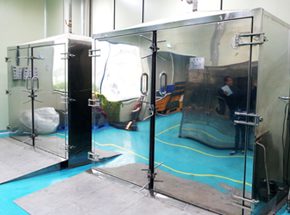
A. Write as Ginseng, Read as ‘Sim’!
The word ‘Ginseng’ is widely known today, but Korean genuine Ginseng has another pretty name called ‘Sim’. The name ‘Sim’ was used from old times, as it is even appeared in the medical book published in 1400s during the Chosun Dynasty.
A. Of course Ginseng is from Korea!
The hometown of Ginseng is Korea, but Ginseng is first introduced by literatures in China. This is the reason why people think China as the origin or Ginseng. However, considering the climate or geological characteristics, Ginseng may only be grown in the Korean Peninsula and some region in Manchu. It is somewhat doubted that Chinese first discovered the Ginseng and used it as medicine. We can also notice from historical dramas how Chinese were greedy for our Ginseng. It is not logical to say that the Korean Peninsula is not the origin of the Ginseng.
A. Grade and effect is different based on the origin.In Korea and Japan, Ginseng is the root of araliaceous Ginseng (Panax ginseng C.A. Meyer) with the thin root and cork layers removed. There are 10 or more types of plants in this kind globally. Among them, Goryeo Ginseng, called as Gin-insam, planted in Korea was popular for the best medicine. It was also considered as medicinal herb given by God, called as divine or sacred herb. Recently, ginseng with the scientific name of Panax quinquefolius L is started to be planted in China. This is western ginseng or tienchi seng. Ginseng harvested in Japan resembles the root of bamboo. It has totally different remedial effect with ‘Ginseng’, so be careful!
| Name (Scientific) | Number of Leaves | Root Morphology | Origin |
|---|---|---|---|
| Korea Ginseng | 5 | Human-like | Korea, Manchu |
| Western seng | 5 | Conical | Korea, Manchu |
| Tienchi seng | 5~7 | Small carrot | East of North America |
| Bamboo Ginseng | 5 | Bamboo root | China Yunnan |
| 3-Leaves Ginseng | 3 | Sphere | East of North America |
| Himalayan Ginseng | 5 | Spherical root | Nepal |
| Ginsenoside | General Effect |
|---|---|
| Ginsenoside Rb1 | Restraining central nerves, antipyretic analgesic, protect liver function |
| Ginsenoside Rb2 | Anti-diabetic, Anti-arteriosclerosis, liver cell proliferation, control immune system |
| Ginsenoside Rc | Pain reduction, promoting synthesis of protein and lipid |
| Ginsenoside Rd | Promoting secretion of adrenocortical hormone |
| Ginsenoside Re | Protecting liver, promoting synthesis of marrow cells, enlarging blood vessels |
| Ginsenoside Rg1 | Strengthening immune function, improving learning function, anti-fatigue |
| Ginsenoside Rg2 | Restraining platelet aggregation, improving hypomnesia |
| Ginsenoside Rg3 | Restraining metastasis of cancel cells, protecting liver, restraining anticancer tolerance |
| Ginsenoside Rh1 | Liver protection, anti-cancer, restraining platelet aggregation |
| Ginsenoside Rh2 | Restraining growth of cancel cells, improving skin immunology |
| Ginsenoside Rf | Pain reduction of brain nerve cell, restraining lipid and oxidation |
| Ginsenoside Ro | Alcohol detoxification, anti-hepatitis, anti-inflammation |
| Type | Number of roots per packing unit | ||||
|---|---|---|---|---|---|
| 600g | 300g | 150g | 75g | 37.5g | |
| 10-Ji | 14 | 7 | |||
| 15-Ji | 19 | 10 | |||
| 20-Ji | 28 | 14 | 7 | ||
| 30-Ji | 38 | 19 | 10 | 5 | |
| 40-Ji | 48 | 24 | 12 | 6 | 3 |
| 50-Ji | 58 | 29 | 15 | 8 | |
| 70-Ji | 78 | 39 | 20 | 10 | |
| So-Ji | 70~100 | 40~50 | 21~25 | 11~13 | |
 < 사진출처 : (사)한국인삼연합회 >
< 사진출처 : (사)한국인삼연합회 >-
Q. Should people with lots of heat not take ginseng?A. To conclude, ginseng itself does not act as cooling or warming our body. The oldest Chinese medicinal literature, Sinnongbochokyeong, is used as an index to identify how long a medicinal herb is used. This literature introduces 365 kinds of medicinal herbs and records ginseng as ‘warm’ herb. Another ancient Chinese literature also refers Korean ginseng as ‘warm’. But the word ‘warm’ used in this literatures means ‘sweet’ or ‘bitter’ instead of representing temperature.
-
Q. Then where has this kind of misunderstanding come from?A.It is because of the wrong marketing.North American sellers translated warm and cold wrongly in order to sell more products to the Southeast Asia, where people have much interest on their health. In the actual research performed at Vietnam for 3 months, only excellent remedial effects of ginseng, on metabolism and peripheral nervous system, has been proved. There was no elevation of body temperature observed.
-
Q. What exactly is the heating phenomenon?A. Based on the result of clinical test, temperature was remained still but only blood flow and its speed increased. Also, it was only the subjective feeling of being heated. It is same as that we feel warm and full after having a meal, with the digestive process and metabolism activated and promoted.
For more information, please check out news article






















- What is special about world’s renounced Cheonsamwon TAEGEUKSAM?
- ‘TAEGUEKSAM’, only produced and sold at Korea Ginseng, has a little special characteristic. TAEGUEKSAM refers to the fresh ginseng simmered in the boiling water of 80-90 degree Celsius for 10~20 minutes followed by dehydrating process. Its formation is straight while outside color is light brown, unlike red ginseng, but inside color is reddish brown as red ginseng. With its unique formation, TAEGEUKSAM can be boiled down or sliced into the pieces for tea. Some people intake raw TAEGUEKSAM without further process. Ginseng product is commonly known as its heating effects. But red ginseng or TAEGUEKSAM can also be taken by people with high temperature.
- Knowing heating phenomenon right

Outside is porcelain brown,

but inside has burning red color.

